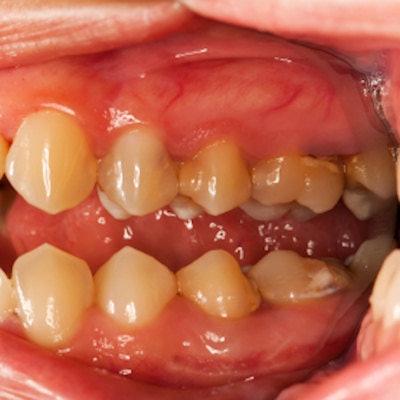
How can dental practitioners and organizations increase global awareness and prevention of periodontal disease? A new white paper and an advocacy guide produced by the FDI World Dental Federation provide tips on suggested actions for improving periodontal health.
How can dental practitioners and organizations increase global awareness and prevention of periodontal disease? A new white paper and an advocacy guide produced by the FDI World Dental Federation provide tips on suggested actions for improving periodontal health.
The white paper includes comprehensive information on the global prevalence and impact of periodontal disease, strategies for its prevention and treatment, and a discussion of key challenges and suggested actions for its management. Meanwhile, the practical guide offers information for dental organizations on developing advocacy programs to help promote better periodontal health. They are both available on the FDI's website.
"The practical guide helps oral health professionals establish advocacy goals that will reach policymakers and contributes to implementing successful campaigns," said Lijian Jin, DDS, PhD, chair of the Global Periodontal Health Project Task Team for FDI World Dental Federation and a co-author of both documents.
Dr. Jin is also a clinical professor of periodontology at the University of Hong Kong. The lead author of the documents was David Herrera, DDS, PhD, a professor of periodontics in the University Complutense of Madrid Faculty of Odontology in Spain.
Laying out the issues
Awareness of periodontal health is low among patients and even practitioners even though severe periodontitis is the sixth most prevalent disease or condition worldwide, according to the white paper. Written for oral health professionals, the document provides a comprehensive summary of issues related to periodontal disease, focusing on the following areas:
- Epidemiology and global burden
- Modifiable and nonmodifiable risk factors
- Shared risk factors, such as tobacco smoking and metabolic and dietary risk factors, with other chronic noncommunicable diseases and the relationship to increased levels of systemic inflammation
- Evidence regarding the association with systemic diseases and conditions, such as diabetes and cardiovascular diseases
- Challenges and solutions for reducing periodontal disease worldwide
Risk factors discussed include modifiable ones related to lifestyle, metabolic, dietary, socioeconomic, and stress-related issues, while nonmodifiable factors pertain to genetics, sex, age, and certain systemic conditions.
The authors discussed the importance of increasing awareness of proper oral hygiene among the general public and having early education provided by school teachers and medical and dental professionals. Prevention efforts could help to reduce costs later for restorative dental work and implants.
"Apart from financial aspects, lifelong preservation of the patients' own dentition is of the greatest value and may enhance the health state of the individual with good quality of life," the authors wrote.
Challenges for combatting periodontal disease globally discussed in the white paper include negligence of periodontal diseases in dental checkup procedures and dental education curricula in some countries, as well as reliance on dental implants despite associated risks, such as peri-implantitis.
Only just over half of national dental associations report that periodontal screening is mandatory in a routine dental checkup in their country, and periodontology is a registered specialty in only half of countries surveyed recently by FDI.
Solutions to these challenges include boosting the quality of basic and continuing dental and medical education on periodontal diseases. The authors also suggested advocating that governments include oral health in general health policies and developing partnerships with nongovernmental organizations.
Advocacy tools
Based on the contents of the white paper, the practical guide provides information for dental associations on designing, conducting, and evaluating advocacy campaigns for creating policies that help prevent and manage periodontal disease. It includes key messages in appropriate language for communicating with policymakers.
The practical guide addresses the following elements:
“Rapid improvements could be achieved through easy-to-implement and cost-effective measures, yielding a strong return on investment.”
- Issues on which to focus, such as lack of awareness, access to care, remuneration for preventive care, periodontal screening in routine dental checkups, and care for aging populations
- Potential areas for intervention, such as greater focus by health systems on dental care, professional education, reducing economic barriers, and partnership among dental and medical practitioners
- Disseminating key messages to relevant target audiences through appropriate channels, such as workshops, high-level meetings with officials, public events, mass media, social media, and printed materials
- Partnering with groups, including patients, health professionals, government, manufacturers, payers, and policymakers
"When planning your advocacy campaign, select objectives which seem important and timely in your specific setting, depending on the issues you wish to address," the authors wrote.
Goals and objectives could include arranging a meeting with a political official to have the issue of low awareness addressed by including good oral hygiene in official healthy lifestyle recommendations, they wrote.
"If your focus is aging populations and your goal is a 30% reduction in the prevalence of severe periodontal disease among nursing home residents in your community, then your short-term objectives might be to roll out an education campaign for nursing home personnel," they wrote.
Don't be overly ambitious in periodontal health advocacy planning, and develop SMART (specific, measurable, achievable, realistic, and time-bound) objectives, the authors advised.
"Because of its preventable nature, rapid improvements could be achieved through easy-to-implement and cost-effective measures, yielding a strong return on investment," they wrote.



















